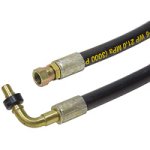J_J
Super Star Member
- Joined
- Sep 6, 2003
- Messages
- 18,973
- Location
- JACKSONVILLE, FL
- Tractor
- Power-Trac 1445, KUBOTA B-9200HST
Carl,
On that hose list did you make up that list? I thought it was unusual that the measurement was just the length of the rubber, and was that the visible rubber. Whenever I have asked the hoseman to build a hose, they take the old hose with fittings and lay it out on a table, and pull out some hose with the fittings laying in the installed position, and then cut the hose, and then crimp.
Andy,
If I asked you for a hose assembly that was 102 in, would you not cut the hose shorter to include the fittings, for a total length of 102 in.
I noticed that some of the fittings cover the ends of the rubber anywhere from 1.5 to 2 in.
On some of the hose assemblies, when you do not have the old hose, and it has a 90 degree bend in the fitting, do you ask the customer if the length is to the middle of the bend or does it include the total bend. My thinking is that the middle of the bend would be the true distance.
On that hose list did you make up that list? I thought it was unusual that the measurement was just the length of the rubber, and was that the visible rubber. Whenever I have asked the hoseman to build a hose, they take the old hose with fittings and lay it out on a table, and pull out some hose with the fittings laying in the installed position, and then cut the hose, and then crimp.
Andy,
If I asked you for a hose assembly that was 102 in, would you not cut the hose shorter to include the fittings, for a total length of 102 in.
I noticed that some of the fittings cover the ends of the rubber anywhere from 1.5 to 2 in.
On some of the hose assemblies, when you do not have the old hose, and it has a 90 degree bend in the fitting, do you ask the customer if the length is to the middle of the bend or does it include the total bend. My thinking is that the middle of the bend would be the true distance.

